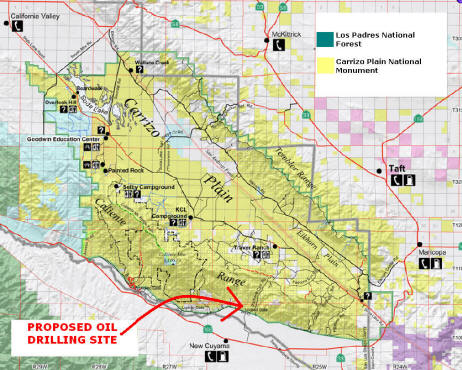Carrizo Plain, CA—The federal Bureau of Land Management has announced that a Bakersfield oil exploration firm will not drill for oil in the Carrizo Plain National Monument near New Cuyama.
Last November, Richard D. Sawyer, the lease holder, filed a “Notice of Staking” with the BLM, announcing his intent to drill an exploratory well inside the monument boundary at Wells Canyon. Under the terms of the lease, Sawyer had until March 15, 2006 to begin the drilling.
Now, according to the BLM, Sawyer will not have enough time to begin drilling by the expiration date, and the drilling company he hired—Longbow LLC—has withdrawn its plans to begin drilling operations.
“Our national monument is safe from expanded oil development,” said Jeff Kuyper, executive director of Los Padres ForestWatch. “We’re relieved that our public lands will not be invaded by drill rigs, access roads, and other infrastructure.”
Oil and gas development including the construction of drilling pads, roads and other infrastructure causes loss and fragmentation of wildlife habitat and other impacts to the environment. The lease where drilling was planned contains suitable habitat for several endangered animals, including the San Joaquin kit fox and the blunt-nosed leopard lizard. The Carrizo Plain National Monument contains one of the highest concentrations of rare plants and animals in the entire state of California.

“The proposed oil drilling site was located in the midst of prime habitat for some of the Monument’s most imperiled plants and animals,” said Geary Hund, California Desert and Monuments Program Director of The Wilderness Society. “We hope this spells an end to new oil drilling in the National Monument. It is simply not a compatible use.”
The oil lease contained suitable habitat for several endangered wildlife species, including the San Joaquin kit fox and the blunt-nosed leopard lizard. At one point, the lease holder had planned to construct a well pad and access road through this area.
If drilling had proceeded and oil was found in the area, Sawyer could have developed all 3,500 acres of his seven oil leases in the area.
The 250,000-acre Carrizo Plain National Monument was established in 2001 to protect one of the last remaining untouched tracts of land in the San Joaquin Valley. The Presidential Proclamation that created the monument prohibits any new oil leases inside the monument boundaries, but allowed existing leases to be developed. Sawyers’ leases are among 18 “grandfathered” in when the national monument was formed. The other leases are at three locations within the monument and have already been drilled.







Comments are closed.